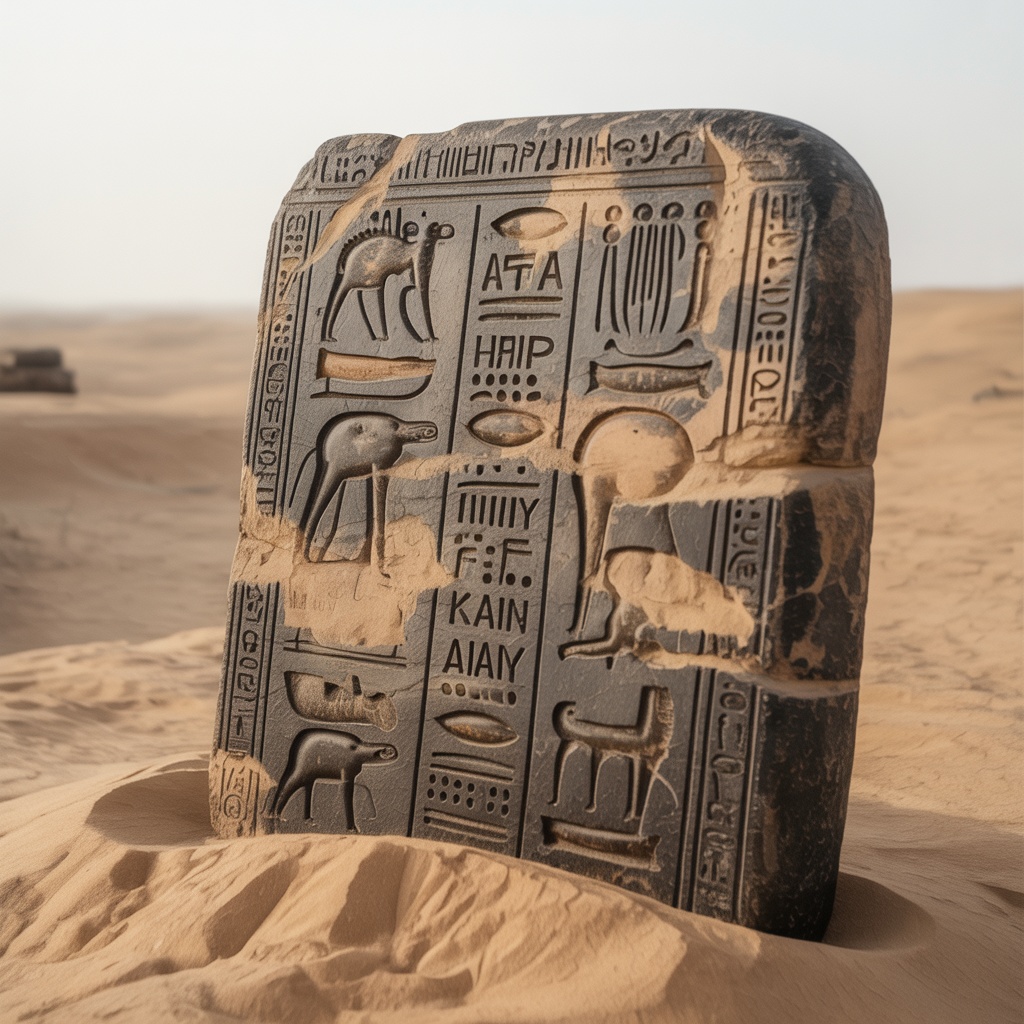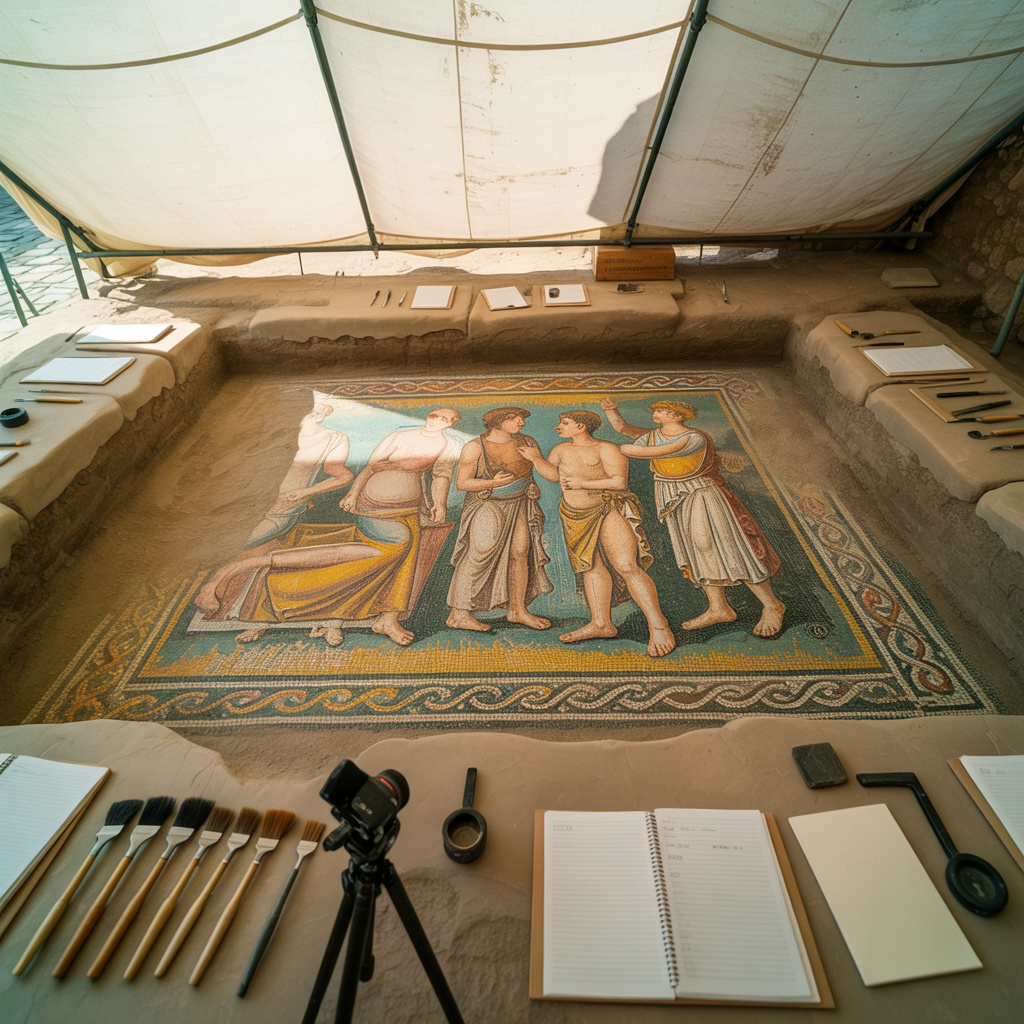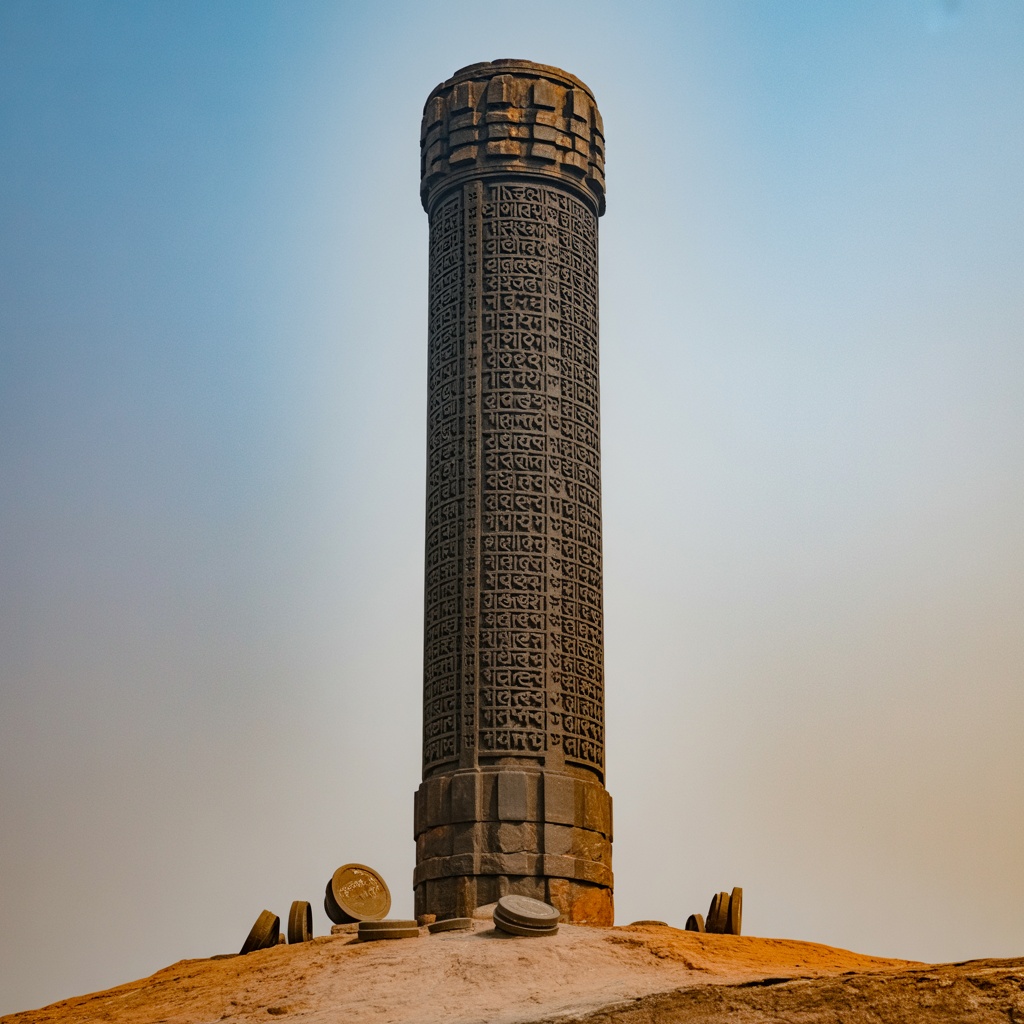Standing in the Qutb complex in Delhi, a remarkable testament to ancient Indian metallurgical prowess has withstood over 1,600 years of monsoons, heat, and atmospheric exposure without succumbing to rust. The Iron Pillar of Delhi, weighing approximately six tonnes and standing 7.21 metres tall, represents a technological achievement that mystified materials scientists for decades and continues to inspire research into ancient manufacturing techniques that may hold lessons for contemporary industry.
As specialists in archaeological heritage expeditions, we've guided numerous metallurgists, historians, and curious travellers to examine this extraordinary artefact. This comprehensive analysis explores the pillar's historical origins, the scientific explanations for its corrosion resistance, and its significance within the broader context of ancient Indian technological advancement.
Historical Origins and Dating
The Iron Pillar bears a Sanskrit inscription in Brahmi script identifying it as a memorial to a ruler named Chandra, generally identified as Chandragupta II Vikramaditya who reigned from approximately 375-415 CE during the Gupta Empire's golden age. The inscription describes Chandra's military conquests and virtues, proclaiming his fame reaching from the Himalayas to the southern ocean.
Archaeological evidence suggests the pillar originally stood in a Vishnu temple, topped by a Garuda (the eagle mount of Vishnu), functioning as both architectural support and devotional monument. The pillar's current location in the Qutb complex came about through relocation, though the exact circumstances and timing remain debated. Most scholars believe it was moved during or shortly after the construction of the Quwwat-ul-Islam mosque by Qutb-ud-din Aibak in the late 12th century, repurposed as an ornamental feature within the Islamic architectural ensemble.
The Gupta Period and Technological Innovation
The Gupta Empire (approximately 320-550 CE) is recognised as a high point in Indian civilisation, witnessing advances in mathematics, astronomy, literature, and material technology. This period produced the concept of zero, advances in decimal notation, sophisticated astronomical calculations, and clearly—based on the Iron Pillar's evidence—exceptional metallurgical capabilities.
The pillar represents not merely artistic achievement but also logistical and engineering mastery. Creating a six-tonne iron object required mining substantial ore quantities, reducing the ore to metallic iron, and welding together smaller iron blooms (the spongy masses produced by ancient iron smelting) to create the unified column. Each step demanded sophisticated technical knowledge and coordinated labour.
The Mystery of Corrosion Resistance

For decades, the Iron Pillar's resistance to rust puzzled scientists. Iron typically oxidises rapidly when exposed to moisture and oxygen, yet this pillar has endured Delhi's monsoon seasons and temperature extremes for over sixteen centuries with minimal corrosion—only a slight surface pitting rather than the destructive rust that would normally consume exposed iron within years or decades.
Scientific Investigation and Explanations
Serious scientific analysis began in the early 20th century, with metallurgists collecting samples and conducting compositional analyses. These investigations revealed several factors contributing to the pillar's longevity:
High phosphorus content: The iron contains approximately 1% phosphorus, significantly higher than typical ancient iron and modern commercial iron. When exposed to atmospheric moisture, this phosphorus combines with iron, oxygen, and hydrogen to form a protective layer of misawite (a compound of iron, oxygen, and hydrogen) approximately one-twentieth of a millimetre thick. This thin film prevents oxygen from reaching the underlying metal, halting further corrosion.
Low sulphur and magnesium content: Ancient Indian iron-making techniques produced metal remarkably free from sulphur and magnesium, impurities that would accelerate corrosion. The low sulphur content (less than 0.05%) particularly contributes to corrosion resistance, as sulphur promotes rust formation in moisture.
Manufacturing method: The pillar was constructed by forge-welding numerous smaller iron pieces together—a labour-intensive process that nonetheless produced a more homogeneous structure than casting would have achieved. This forging process created a slag coating rich in phosphorus that further protects the surface.
Environmental factors: Delhi's climate, despite monsoons, features periods of extreme dryness and strong sunshine that help the protective phosphate layer form and maintain itself. The pillar's location in a relatively open area with good air circulation prevents moisture accumulation that might defeat the passive protection system.
Modern Research and Continuing Studies
Recent research using advanced analytical techniques including X-ray diffraction, scanning electron microscopy, and electrochemical impedance spectroscopy has provided increasingly detailed understanding of the protective mechanisms. Studies conducted by the Indian Institute of Technology and other institutions have confirmed that the protective layer is indeed misawite forming through the interaction of phosphorus-rich iron with atmospheric elements.
This research has practical applications. Understanding the ancient Indians' technique for creating corrosion-resistant iron may inform modern metallurgy, particularly for applications requiring durable materials without complex protective coatings. Some researchers are exploring whether similar phosphorus-enriched iron could provide cost-effective corrosion protection for contemporary infrastructure.
Manufacturing Technology and Ancient Techniques

Iron Production in Ancient India
Ancient Indian ironworkers used bloomery furnaces, where iron ore was heated with charcoal to approximately 1,200 degrees Celsius—hot enough to reduce the ore to metallic iron but below iron's melting point. This process produced a spongy mass called bloom, containing reduced iron mixed with slag and unreacted material. Smiths then hammered the bloom to squeeze out slag, consolidating the iron into usable metal.
The high phosphorus content in the Delhi pillar's iron likely derives from the specific ore used—Indian iron ores in certain regions contain naturally elevated phosphorus levels. The ancient smiths may not have deliberately sought high-phosphorus ore for its corrosion resistance (though this remains debatable), but they certainly recognised superior ores through empirical observation and preferentially selected sources that produced quality iron.
The Welding Process
Creating a six-tonne monolithic pillar from individual blooms required sophisticated forge-welding techniques. Each bloom, weighing perhaps 10-20 kilograms after consolidation, had to be heated to approximately 1,300 degrees Celsius and hammered against the growing pillar, creating solid metallic bonds between the pieces. This process demanded:
- Precise temperature control to ensure proper welding without burning the metal
- Coordinated labour teams managing furnaces, transporting hot metal, and operating heavy hammers
- Sequential welding strategy to build up the pillar progressively
- Quality control to ensure weld integrity throughout the structure
The fact that these welds have held for 1,600 years, maintaining structural integrity whilst the pillar stood as a freestanding column, demonstrates exceptional metallurgical skill. Modern analysis shows the welds are virtually invisible and as strong as the base metal—a remarkable achievement for ancient technology.
Visiting the Iron Pillar: Practical Information
The Iron Pillar stands within the Qutb complex in South Delhi, a UNESCO World Heritage Site that includes several architecturally and historically significant structures including the Qutb Minar (the world's tallest brick minaret), the Quwwat-ul-Islam mosque, and various ruins from different periods.
Location and Access
The Qutb complex lies in Mehrauli, approximately 15 kilometres south of central Delhi. Metro access via the Yellow Line to Qutb Minar station provides convenient public transport. The complex opens daily from sunrise to sunset, with entry fees (nominal for Indian nationals, higher for foreign tourists) supporting site maintenance and conservation.
Security regulations following vandalism incidents now prevent visitors from touching the pillar directly—it stands behind a protective barrier. This restriction disappoints some visitors who've read about the tradition of standing with back against the pillar and attempting to encircle it with arms, but the policy protects this irreplaceable artefact from accelerated wear.
Best Time to Visit
Delhi's climate creates distinct visiting considerations. October through March offers comfortable temperatures for exploring outdoor archaeological sites, with January and February providing the most pleasant conditions. April through June brings extreme heat (40-45 degrees Celsius) that makes midday site visits uncomfortable. Monsoon season (July-September) brings rain that can disrupt visits but also creates dramatic skies for photography.
Morning visits immediately after opening or late afternoon visits approaching closing provide the best light for photography and more comfortable temperatures. The complex attracts substantial tourist and student groups, particularly on weekends and school holidays, so weekday visits offer more peaceful experiences.
Combining with Other Delhi Heritage Sites
A comprehensive day can combine the Qutb complex with other nearby heritage sites. Mehrauli Archaeological Park, adjacent to the Qutb complex, contains over 100 monuments spanning multiple periods from the 10th century onwards. The park receives far fewer visitors than the main complex, offering opportunities for discovery and exploration.
Our archaeological heritage tours arrange expert-guided Delhi expeditions that contextualise the Iron Pillar within broader patterns of Indian technological and artistic achievement, visiting multiple sites that collectively illustrate Indian civilisation's continuity and innovation across millennia.
The Pillar in Cultural and Religious Context

Symbolism and Function
Beyond its metallurgical significance, the Iron Pillar held religious and symbolic meaning. In Hindu cosmology, pillars represent the axis mundi—the cosmic axis connecting earth and heaven. The pillar's original Garuda capital would have emphasised this vertical symbolism, with Vishnu's mount pointing skyward.
The inscription's reference to Chandra's fame reaching from mountains to ocean employs standard Sanskrit royal eulogistic language, but the pillar's physical presence transformed abstract claims into material reality—a permanent monument projecting political and religious authority across generations. Kings throughout history have used monumental architecture and engineering achievements to demonstrate power and secure posthumous remembrance; the Iron Pillar admirably fulfilled this function.
The Pillar's Relocation and Islamic Period
The pillar's incorporation into an Islamic architectural complex represents the complex heritage layering characteristic of South Asian history. Rather than destroying the obviously non-Islamic monument, the new Muslim rulers appropriated it, perhaps recognising its technological impressiveness or simply finding it useful as an architectural ornament. This pragmatic reuse created an unusual juxtaposition—a Gupta-period Hindu memorial standing beside 12th-century Islamic architecture—that embodies Delhi's multicultural historical inheritance.
Broader Context: Ancient Indian Metallurgy
The Iron Pillar, whilst exceptional, represents one example within a broader tradition of sophisticated Indian metallurgy. Archaeological evidence documents advanced metalworking across ancient India:
Wootz Steel
Ancient Indian smiths developed high-carbon steel called wootz (from the Kannada word ukku), renowned throughout the ancient world. This steel, produced through careful manipulation of carbon content during smelting and forging, could be forged into blades of exceptional sharpness and durability. Wootz steel was exported to the Middle East, where it became famous as Damascus steel when worked by Syrian bladesmiths.
The technology for producing wootz steel was partially lost following European colonial disruption of traditional craft knowledge, though recent research has reconstructed the essential processes. Modern metallurgists recognise that ancient Indian smiths empirically discovered techniques for creating steel microstructures that materials scientists now understand theoretically but which remain challenging to manufacture consistently.
Bronze Casting
Ancient Indian craftspeople mastered sophisticated bronze casting techniques, including lost-wax casting for creating complex sculptural forms. The Chola bronzes from medieval South India represent perhaps the pinnacle of this tradition—exquisite religious sculptures cast with extraordinary precision and artistic sensitivity. However, bronze working in India dates back millennia earlier, with sophisticated examples appearing in Indus Valley Civilisation sites from approximately 2500 BCE.
Gold and Silver Working
Ancient Indian jewellers developed refined techniques for working precious metals, including sophisticated alloys, granulation (attaching tiny metal spheres to surfaces), filigree (delicate metalwork using thin wires), and enamelling. These craft traditions continued across centuries, with regional variations creating distinct artistic styles whilst maintaining technical excellence.
Lessons from Ancient Technology
The Iron Pillar offers several important lessons for contemporary archaeology and technology:
Empirical Knowledge and Traditional Technology
Ancient craftspeople developed sophisticated technologies through empirical experimentation and accumulated knowledge passed across generations. They achieved remarkable results without formal scientific theory—the ancient Indians who created the pillar understood what produced quality iron without understanding oxidation chemistry or crystallography. This demonstrates that effective technology need not depend on theoretical science, though scientific understanding can help preserve, transmit, and improve traditional techniques.
Sustainability and Durability
Modern infrastructure typically designs for limited service life—decades rather than centuries. The Iron Pillar's millennium-plus durability challenges assumptions about acceptable longevity and questions whether contemporary civilisation adequately values long-term thinking. Materials that remain functional for sixteen centuries obviously cost more initially than alternatives lasting mere decades, but the life-cycle economics may favour the durable approach, particularly when environmental costs of replacement enter calculations.
Lost and Recovered Knowledge
The temporary scientific puzzlement about the pillar's corrosion resistance illustrates how technological knowledge can be lost when cultural continuity breaks. Colonial disruption, industrialisation, and social change have severed many connections between contemporary Indians and ancestral technical knowledge. Recovery requires archaeological investigation, materials science research, and efforts to document surviving traditional practices before they disappear entirely.
Controversies and Alternative Theories
Like many remarkable ancient artefacts, the Iron Pillar has attracted pseudoscientific speculation alongside legitimate research. Some fringe theorists propose that the pillar's technology proves ancient Indian access to lost civilisations, extraterrestrial contact, or other extraordinary explanations. These claims misunderstand both the pillar's actual properties and the capabilities of ancient technology.
The pillar is remarkable but not miraculous. Its corrosion resistance results from natural phosphorus content in the ore combined with skilled metallurgical practice—impressive but explicable through materials science. Claims that the pillar contains unusual elements, exhibits impossible properties, or could not be replicated with ancient technology have been thoroughly debunked by careful scientific analysis.
This pattern—where legitimate archaeological mysteries attract unfounded speculation—underscores the importance of scientific investigation and evidence-based interpretation. The actual history of the pillar, properly understood, reveals a sophisticated ancient civilisation fully capable of impressive technological achievements without requiring supernatural or extraterrestrial intervention.
